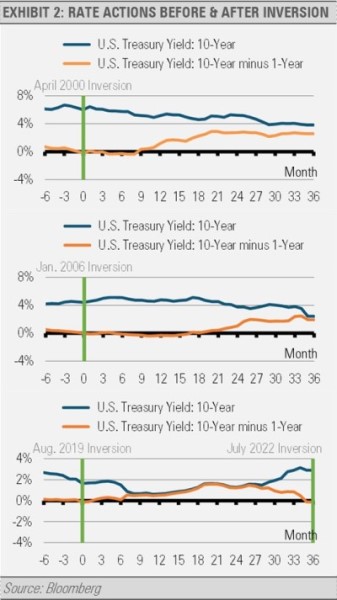Yield curve inversions happen when short-term interest rates rise above long-term interest rates. Inversions usually convey the bond market’s expectations for an economic slowdown or possible future recession, which could impact the U.S. Federal Reserve’s (Fed) future rate decisions. The current inversion coincided with two quarters of negative GDP growth, which is one of the signals typically associated with a recession. However, there does remain some optimism regarding the resilience of the U.S. economy given the strength of the labor market and industrial production. For fixed income investors, this environment is challenging and can highlight the importance of active fixed income management. In other words, understanding the movement of yields can help uncover potential opportunities regardless of the direction of the markets.

The current yield curve inversion is especially profound with both the 1-Year and 2-Year Treasury yields considerably higher than the 10-Year Treasury yield. Recently, spread between the 10-Year Treasury and the 1-Year Treasury reached 0.5% making this the clearest inversion since 2007.
It’s also important to mention that we have seen a significant lift of the entire yield curve. In fact, after more than 40 years of a declining interest rate environment, we are now in the third year of rising rates since the 10-year Treasury fell to a historical low of close to 50 basis points.
While the rise in rates might be helpful for those liquid investors seeking yield, there is valid concern that most yield curve inversions correspond to periods of Fed rate hikes and are the bond market’s signal that there has been a potential overreach. This happens when there is a decoupling between the pace of rate increases and the yield on the 10-year Treasury. While the Fed has more influence on short-term rates, the yield on the 10-Year Treasury is more indicative of the market’s expectations for future inflation and economic growth. Importantly, the Fed’s views and the market’s expectations are not always synchronous.
During a tightening cycle, existing bond holders, especially on the longer end of the curve, fear rising interest rates due to the inverse relationship between yields and bond prices as higher rates mean a loss in value of their bonds. On the other hand, yield seekers have better opportunities when rates rise as their bonds mature, or liquidity becomes available for new purchase at higher yields. As the yield curve inverts, investors who have the ability to be more nimble across various types of credit qualities, maturities, and sectors may have an advantage. Still, maneuvering through a Fed rate hike cycle and inverted yield curve can be taxing for many investors. However, we think these periods highlight the potential benefits of actively managing a fixed income allocation. Our investment decisions are multifaceted to help bond investors attempt to minimize the downside risk in case long-term rates rise, and to also provide some protection if there is a Fed policy mistake that sends longer rates down sharply.
The previous charts demonstrate how volatile the bond market can be during and following an inversion. While not all inversions take the same path, the one common denominator is that the yield on the 10-Year Treasury is usually considerably lower within a year following an inversion. This means that we experience a bond market rally in most periods following a curve inversion, which is associated with a slowing economy and flight to quality.
Managing duration, curve positioning, and sector selection can help add value and protection during these periods. In the runup to a shift in Fed policy, investors can position their allocations accordingly. For example, with the expectation that all rates will initially rise with Fed rate hikes, investors can decrease their overall duration by adding exposure to floating rate bonds as we did in our Strategies. This can help lower interest rate risk by overweighting shorter duration bonds and mitigating the negative impact of higher interest rates on price. Importantly, as short-term rates increase, floating rate bond coupon rates adjust with the market interest rate. After the initial shock, investors might want to reduce their short duration exposure and reallocate more to intermediate duration core bonds and longer duration taxable municipal bonds.
There are several methods to navigating challenging fixed income markets, and we favor actively managing at least a portion of the allocation rather than the more traditional buy and hold fixed income strategy. It is also important to understand the objective of the fixed income allocation for each investor, which depends on risk tolerances, goals, and many other factors. We believe a fixed income allocation may be enhanced with the inclusion of active management to potentially mitigate downside risk while maintaining the integrity of the portfolio.
yields and bond prices as higher rates mean a loss in value of their bonds. On the other hand, yield seekers have better opportunities when rates rise as their bonds mature, or liquidity becomes available for new purchase at higher yields. As the yield curve inverts, investors who have the ability to be more nimble across various types of credit qualities, maturities, and sectors may have an advantage. Still, maneuvering through a Fed rate hike cycle and inverted yield curve can be taxing for many investors. However, we think these periods highlight the potential benefits of actively managing a fixed income allocation. Our investment decisions are multifaceted to help bond investors attempt to minimize the downside risk in case long-term rates rise, and to also provide some protection if there is a Fed policy mistake that sends longer rates down sharply.

The previous charts demonstrate how volatile the bond market can be during and following an inversion. While not all inversions take the same path, the one common denominator is that the yield on the 10-Year Treasury is usually considerably lower within a year following an inversion. This means that we experience a bond market rally in most periods following a curve inversion, which is associated with a slowing economy and flight to quality.
Managing duration, curve positioning, and sector selection can help add value and protection during these periods. In the runup to a shift in Fed policy, investors can position their allocations accordingly. For example, with the expectation that all rates will initially rise with Fed rate hikes, investors can decrease their overall duration by adding exposure to floating rate bonds as we did in our Strategies. This can help lower interest rate risk by overweighting shorter duration bonds and mitigating the negative impact of higher interest rates on price. Importantly, as short-term rates increase, floating rate bond coupon rates adjust with the market interest rate. After the initial shock, investors might want to reduce their short duration exposure and reallocate more to intermediate duration core bonds and longer duration taxable municipal bonds.
There are several methods to navigating challenging fixed income markets, and we favor actively managing at least a portion of the allocation rather than the more traditional buy and hold fixed income strategy. It is also important to understand the objective of the fixed income allocation for each investor, which depends on risk tolerances, goals, and many other factors. We believe a fixed income allocation may be enhanced with the inclusion of active management to potentially mitigate downside risk while maintaining the integrity of the portfolio.
DISCLOSURES
Any forecasts, figures, opinions or investment techniques and strategies explained are Stringer Asset Management, LLC’s as of the date of publication. They are considered to be accurate at the time of writing, but no warranty of accuracy is given and no liability in respect to error or omission is accepted. They are subject to change without reference or notification. The views contained herein are not be taken as an advice or a recommendation to buy or sell any investment and the material should not be relied upon as containing sufficient information to support an investment decision. It should be noted that the value of investments and the income from them may fluctuate in accordance with market conditions and taxation agreements and investors may not get back the full amount invested.
Past performance and yield may not be a reliable guide to future performance. Current performance may be higher or lower than the performance quoted.
The securities identified and described may not represent all of the securities purchased, sold or recommended for client accounts. The reader should not assume that an investment in the securities identified was or will be profitable.
Data is provided by various sources and prepared by Stringer Asset Management, LLC and has not been verified or audited by an independent accountant.

